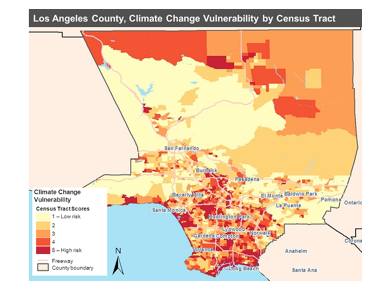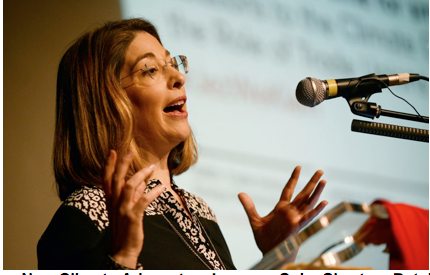CommentsPLATKIN ON PLANNING--While we plebeians dawdle away our lives cooking, cleaning, studying, working, raising families, and helping friends and relatives in need, we can (kind-of) sleep comfortably knowing our local elected officials are hard at work combatting climate change … through press conferences. Luckily for them, they have Donald Trump as their climate foil, blasting away at him with their sound bites for pulling the United States out of the Paris Climate Accord.
Exhibit 1 is the new Los Angeles Climate Mobilization Initiative, co-sponsored by prominent progressive author Naomi Klein (photo above) and LA City Councilmember, Paul Koretz. Their initiative, “wants to achieve a just, carbon neutral Los Angeles by 2025.” In a joint press conference on the grounds of City Hall, they recently set forth this goal as the essence of their approach to thwart Trump-induced climate change at the municipal level. Invoking World War II, they have also announced that, “An actionable LA Victory Plan is in the works that would radically transform the City across sectors on an emergency basis.”
Exhibit 2, striking a similar blow against this dire threat to humanity, is the Path to Positive - Los Angeles -- with Mayor Eric Garcetti at the podium -- and its Declaration on Climate Action. This initiative wants “positive” – whatever that means -- climate change solutions by changing individual behavior, engaging elected officials, and selectively supporting candidates for public office. At its recent press conference, Los Angeles Mayor Eric Garcetti, summed up its mission as, “In L.A., we’re forging a path forward to address #ClimateChange and create a better future for generations of Angelenos.”

While the Klein/Koretz Climate Mobilization initiative comes off as a grass roots effort, kicking off with a wheelchair bound Native American elder offering a small prayer circle her opening invocation, the Path to Positive - Los Angeles is strictly top-down. Its focus is electoral politics; its “positive” program is also completely vague, and its sponsors include a list of corporate-funded non-profits.
Despite these cosmetic differences, both climate initiatives have one thing in common. They are totally devoid of specifics about what Los Angeles, especially City government, should actually pursue to mitigate and adapt to climate change. As I have previously written for CityWatchLA, this is not a mystery waiting for answers. Cities around the planet already have a large toolbox of field-tested policies and successful programs to address and adapt to climate change. We even know the not-too-secret code to open the toolbox: it is money achieved through increased taxes and re-allocating public budgets.
If the climate initiatives championed by Mayor Garcetti and by Councilmember Paul Koretz are serious, and not just anti-Trump media campaigns, then these pols need to become leading advocates for dipping deep into LA’s municipal budget to address climate change. Invoking WW II, like they do, has significant financial consequences. In current, inflation-adjusted dollars the United States spent over $4 trillion between 1941-1945 in that war.
Is there a remote chance that our local heroes will take the lead in applying City Hall’s considerable resources to their vague initiatives? If so, they will need to systematically rework the City’s budget, the work programs of every City department, and bulk up the regulatory power of local government to address climate change. (If this actually happens, I will be flabbergasted, but pledge to immediately share these sea-changes with CityWatchLA readers.)
This, then, is what they ought to do:
Don’t leave climate change policies and programs to chance. City Hall must integrate the City’s extensive policies and programs into a General Plan Climate Change element. Next, they should closely monitor this Plan’s rollout, as well as its successes and failures in mitigating and adapting to climate change.
However, to make Los Angeles “carbon neutral by 2025” or to create “a positive long-term future for Angelinos based on mitigating climate change” is no easy task. It cannot be done through press conferences, photos ops, and well-honed telegenic sound bites. It actually requires a detailed, properly funded, legally adopted and binding plan that specifies and then monitors the role for each City department agency to mitigate and adapt to climate change.
In fact, a template for this comprehensive General Plan Climate Element already exists, the King County (Washington) Strategic Climate Action Plan, a refinement of King County’s widely-copied 2007 Climate Plan. Furthermore, in California the Governors Office of Planning and Research has already carefully outlined an optional General Plan Element focused on climate change and global warming.
Finally, like the Southern California Association of Government (SCAG), UCLA’s Institute of the Environment and Sustainability has been a long-term clearinghouse for integrating and applying Federal, State, and local programs that address climate change in the Los Angeles region.
Instead of gutting the California Environmental Quality Act (CEQA) through streamlining, up-zoning, and up-planning, CEQA should be expanded. This means eliminating many categorical exemption categories, such as ignoring polluting McMansions, and replacing pro-forma Mitigated Negative Declarations with full Environmental Impact Reports (EIRs). It also means that the City Council must adhere to all EIR climate-related findings by redesigning projects and plans in order to eliminate their adverse environmental impacts.
This is the obvious way to prevent the unmitigatable generation of Green House Gases caused by real estate speculation. If Mr. Garcetti and Mr. Koretz, along with Miss Klein, are serious about achieving a carbon-neutral Los Angeles within the next eight years, this is the obvious place to begin, even if it means biting the real estate hand that so-well feeds them.
Tree Planting: Of all the easily available local options to quickly mitigate and adapt to climate change, wide-spread tree planting is at the top of the list. In this regard, Los Angeles is the perfect candidate. Its semi-tropical climate supports 1000 approved tree species, while most LA neighborhoods and corridors are in desperate need of systematic tree planting and subsequent care.
Within a few years, most tree species will naturalize, with no additional water needed. The trick, though, is to widely plant many different tree species. This approach minimizes the deadly impact on invasive insects and plant diseases, already present in Southern California. For this approach to work, though, the City of L.A. must be in charge, and the bill will be high, over $1 billion, or the cost of one new Northrop-Grumman B-2 Spirit bomber.
Transportation Infrastructure: Get people out of their cars with carrots, not sticks. For the past 70 years City Hall’s planning mission was to make automobile traffic flow smoothly, despite the overall increase in the numbers of cars and trucks. While the traffic planners played this game well for many decades, the incredible gridlock in most of Los Angeles now means this game is over.
Their efforts, though, did achieve one continuing -- if dubious -- success. It habituated most Angelenos to their cars. Unless they are the transit dependent (elderly, students, handicapped, or poor), nearly everyone in LA relies on their car(s) for mobility, even when the streets are hopelessly gridlocked and when there are new alternative transportation modes. The challenge at this point is to make those alternative transportation modes so convenient that people will comfortably stop driving their cars, similar to New York and San Francisco, where public transit is an inherent part of the built environment.
The other transportation carrots include the following:
- Repairing and widening LA’s sidewalks, installing ADA ramps at corners, and improving pedestrian safety at all cross-walks.
- Upgrading street lighting so sidewalks are well lit at night, and all pedestrian paths feel safe.
- Enhancing bike-sharing, protected bike lanes, and bicycle parking infrastructure, similar to the bicycle-friendly systems already rolled out in other cities, like Seattle, Portland, Minneapolis, Tucson, and New York City.
- Finally, in the Los Angeles area METRO’s plans for mass transit expansion reaching past 2050, must be accelerated. Even if this requires postponing another foreign war or an additional aircraft carrier fleet to pay for these domestic infrastructure improvements, it should be done.
Obviously, this list is not definitive. A more complete list, such as King County’s template, the Governors Office of Planning and Research guidelines, and the Southern California Association of Government’s regional climate plans, includes many other programs, such as power generation and consumption. The test, therefore, for these two latest Los Angeles climate initiatives is whether they will bite the bullet and take on this vast array of already designated climate change policies and programs.
So far, there is no evidence that this is happening. Presumably this is because most of these programs cost serious public money and conflict with other priorities. This includes City Hall’s quasi-religious belief that real estate speculation is the magic elixir that cures all urban crises, including climate change.
(Dick Platkin is a former Los Angeles city planner who reports on local planning issues for City Watch. Please send comments, corrections, and topics for future columns to [email protected].)
-cw
















